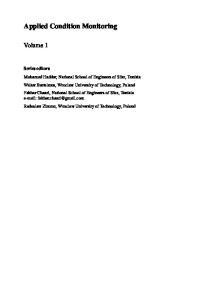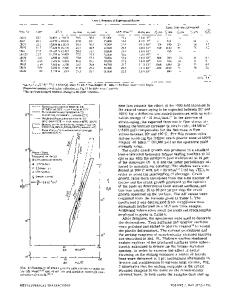Elasto-Plastic Fatigue Crack Growth: Mathematical Models and Experimental Evidence
This paper describes some analytical models developed for the evaluation of the cyclic J-integral, ΔJ. The J-integral is usually obtained through involved graphical procedures with experimental load-load point displacement plots. Numerical and other proce
- PDF / 3,755,675 Bytes
- 64 Pages / 481.89 x 691.654 pts Page_size
- 61 Downloads / 441 Views
J. C. Radon Imperial College of Science and Technology, London, U.K.
Abstract This paper d~~bes some analytical models developed for the evaluation of the cyclic J•integral, ~J. The J-integral is usually obtained through involved graphical procedures with experimental load-load point displacement plots. Numerical and other procedures are even more time consuming. For typical specimens, such as C(T), TPB and DCB (double cantilever beam) the graphical procedures are much simpl~r.An easily applicable analytical formula for the cyclic J-integral, by means of which the integral could be calculated and which would be comprehensive enough to be applicable for the conditions of fatigue and creep would be particularly helpful~ Such a formula may overcome the shortcomings of the graphical and other procedures which are laborious and time consuming, apart from involving considerable experimental work. For developing the analytical model, the two halves of a specimen are considered as cantilevers built-in at the crack tip. Using non-linear
M. P. Wnuk (ed.), Nonlinear Fracture Mechanics © Springer-Verlag Wien 1990
230
J. C. Radon
beam theory the change in the distance between loading pins due to the elastic deformation, plastic deformation, cyclic creep and high temperature creep is evaluated. From this the load-displacement plot is analytically constructed. This gives the change in strain energy of the specimen after a number of cycles and, subsequently, !J. Conditions for load cycling, strain cycling and cycling with incorporated dwell time are also considered.
Introduction The successful application oflinear elastic fracture mechanics (LEFM) analysis in the description of the brittle fracture behaviour of metals under monotonically increasing loads has led to a logical extension to the study of slow crack growth under both static and fatigue loads, commonly termed subcritical crack growth. Subcritical crack growth covers all processes in which a crack slowly propagates at a K level below the critical value Kc corresponding to unstable and catastrophic failure. These may be stress corrosion cracking (SCC), creep cracking, cyclic creep, fatigue crack propagation or any combination of these phenomena. Here, only the fracture mechanics approach to fatigue crack propagation will be considered. It is known that the stress intensity factor, K, or the strain energy release rate, G, govern the intensity or magnitude of the stress field around the crack tip. Since crack extension occurs in this highly stressed region, it is reasonable to assume that the intensity of the crack tip stress field as represented by K should control the rate of crack extension. The cyclic crack growth rate, da/dN, may be a function of the range of the stress intensity factor, M'
:::0
0
~
~
Elasto-Plastic Fatigue Crack Growth
265
20
15 M
0
.......
>
Data Loading...











